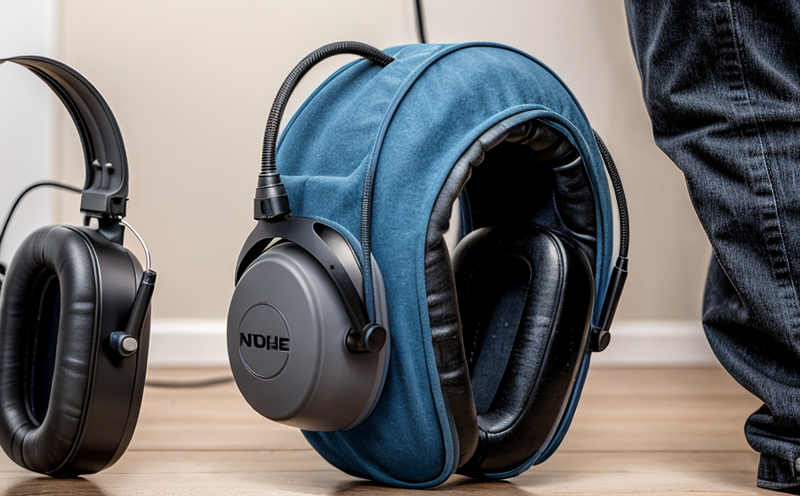EN ISO 4869-1 Hearing Protector Sound Attenuation Testing
The European Standard EN ISO 4869-1 sets forth stringent requirements for the determination of sound attenuation provided by hearing protectors. This test is essential to ensure that protective equipment meets safety and performance standards, thereby safeguarding workers in high-noise environments.
Sound attenuation testing involves measuring the reduction in noise levels provided by a hearing protector when worn over a specified ear canal insert or muff. The standard defines specific procedures for conducting these tests under controlled conditions to ensure accurate measurement of sound attenuation values.
The test setup typically includes an anechoic chamber, which minimizes reflections and ensures precise measurements. A calibrated sound source emits noise at various frequencies, and the hearing protector is placed over a microphone that records the attenuated sound levels. The difference between the unattenuated and attenuated sound levels provides the sound attenuation value.
Proper specimen preparation is critical to obtaining accurate results. This involves ensuring the ear canal insert fits snugly or that the muff is properly seated on the head form. Any gaps can lead to inaccuracies in measuring the true attenuation provided by the hearing protector. The test also accounts for the influence of external factors such as environmental noise, fit factors, and the position of the ear cup.
EN ISO 4869-1 specifies a range of frequencies from 50 Hz up to 20 kHz, with an emphasis on covering critical bands of human hearing. The standard also provides guidance for testing different types of hearing protectors, including earmuffs, plugs, and combination devices.
The results are presented as the average attenuation value over the frequency range specified in the standard. This value is crucial for determining whether a hearing protector meets the required performance levels set by regulatory bodies like OSHA or the European Union.
Accurate sound attenuation testing ensures that workers in noisy environments have effective protection against noise-induced hearing loss. Compliance with this test helps companies meet their occupational safety obligations and demonstrates a commitment to worker health and wellbeing.
Industry Applications
| Industry | Applications |
|---|---|
| Aerospace | Testing hearing protectors for use in noisy environments like aircraft cockpits. |
| Mining | Evaluating the effectiveness of hearing protection used by miners in underground operations. |
| Construction | Assessing hearing protectors for use on construction sites where high noise levels are common. |
| Manufacturing | Determining the sound attenuation provided by earplugs and earmuffs in factory settings. |
- Aerospace manufacturers must comply with strict noise regulations to protect pilots and ground crew from prolonged exposure to high decibel levels.
- Mining companies prioritize worker safety, especially in underground mines where the risk of hearing damage is particularly high.
- Construction firms ensure that workers have adequate protection against the constant barrage of noise on job sites.
- Manufacturing plants must adhere to standards for protecting workers from machinery-generated noise.
Why Choose This Test
The EN ISO 4869-1 test is critical for ensuring that hearing protectors meet the highest safety and performance standards. By conducting this test, companies can:
- Guarantee worker safety in high-noise environments.
- Avoid legal repercussions from non-compliance with occupational health and safety regulations.
- Demonstrate a commitment to corporate social responsibility by prioritizing employee wellbeing.
- Ensure that hearing protectors effectively reduce noise levels as intended, thus enhancing the overall quality of life for workers.
The test also helps companies stay competitive in their industry by ensuring they meet or exceed regulatory requirements. This can lead to a positive reputation and increased customer trust, which are valuable assets in today's market.
Additionally, compliance with this standard is essential for companies that export products internationally, as many countries have adopted the EN ISO 4869-1 as a national standard.
Competitive Advantage and Market Impact
Meeting or exceeding the requirements of EN ISO 4869-1 can provide several competitive advantages for companies in the occupational safety sector:
- Enhanced Worker Safety: Ensuring that hearing protectors meet rigorous testing standards demonstrates a commitment to worker health and wellbeing.
- Regulatory Compliance: By adhering to international standards, companies can avoid costly fines and legal issues associated with non-compliance.
- Positive Reputation: A reputation for safety and quality can attract more customers and enhance the company's standing in the market.
- Increased Market Share: Compliance with this standard can differentiate a company from its competitors, potentially leading to increased sales.
The ability to provide hearing protectors that meet these stringent standards also opens up new markets for companies. For example, firms that comply with EN ISO 4869-1 may find opportunities in countries where the standard is recognized as a national standard.
In conclusion, investing in EN ISO 4869-1 testing can provide significant benefits to companies in the occupational safety sector, helping them stay ahead of the competition and ensure worker safety and satisfaction.





